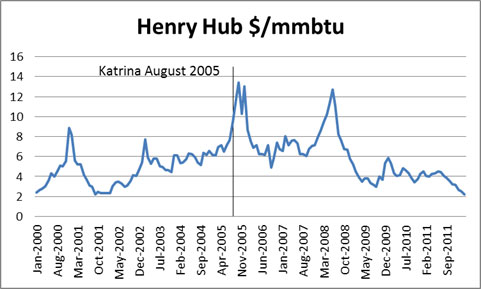Capitalism to Creditism to Green Economy?
Mike Shedlock posted an interesting blog discussing Richard Duncan perception on the end of Capitalism, and the conversion to “creditism”. Mr. Duncan also noted the reversal of the situation is near to impossible, therefore he concludes government should go ahead and borrow and spend money to make the world a better place. Unfortunately, he chooses the recent Green Economy as his choice of government spending pointing out a government solar build out in Nevada would be an ideal project.
Mr. Shedlock argues the issue that government projects never seem to work out as planned. Generally speaking I agree with most of Mr. Shedlock arguments to Mr. Duncan plan. However, I think they both miss the point I have been preaching “Energy is a means to an end.” If the government wants to take the Mr. Duncan suggestions, the most effective way to advance society is to focus on the ends not the means. One can have all the energy in the world, but if you don’t plan on using it in a productive manner that advantage becomes irrelevant. We need to stop with this Green economy concept. We need to think about how we better utilize and use energy in order to produce and manufacture products and services that society can use to better us all. I believe if we do focus on this, naturally, we will produce “greener” energy. However right now we are just fooling ourselves that by making a Green Economy we will be better in the long run. I never have seen a case where if I challenge my means/path it produces a better end.
I am pro-renewables in many ways. The subsidization path, particularly without innovation beyond the engineering sense, will not lead to a better outcome in the long run. I discuss this some more in previous blog.
We positively and evocatively challenge the current thinking involving any aspect of energy use. We look for projects that offer meaningful, transformative, with impactful outcome to the marketplace or society.
Independent analysis and opinions without a bias right is what we offer to our clients. Please consider and contact All Energy Consulting for your consulting needs.
Your Energy Consultant,
614-356-0484
The Demise of Coal Overstated
As I noted in my previous blog, I spoke at a power symposium last week. Many of the speakers had concluded coal is dead. The rhetoric is the same on the internet and major publications. People have even spoken to the point to say coal is more expensive than gas. This is sadly far from the truth.
Weather played a key role in the current price predicament for natural gas. One year should never be extrapolated when weather played such a crucial role – case in point look at the price action in natural gas prices after Hurricane Katrina.
It is a true statement for those trading – “Markets can remain irrational longer than you can remain solvent.” You can see it almost took 6 months for Katrina’s price impact to fade. One could look at the current situation as the inverse situation – instead of a hurricane reducing supply you have a mild winter reducing demand. It takes time for fundamentals to rebalance the market. The price rebalancing can take even longer as noted in the irrational markets discussion. The irrational price levels of today’s market are natural gas prices below coal market contracts. Ultimately those contracts will roll off and the negotiations for the coal contracts will come down or no longer cease to exist. Conservatively, I would estimate we are in the fourth month of un-fundamentally low prices. I can foresee continued pressure downward on natural gas prices, but not past this year as long as we revert to normal weather.
For those saying it is over for coal, they are forgetting their game theory rules. For every action there will be a reaction from those most impacted. Coal consumption could potentially drop over 20% this year relative to last year’s consumption. Inversely gas consumption in the power sector could see a rise of over 60% from last year’s consumption. These two actions do not come without consequences/reactions. As I indicated above, I expect coal prices to come down. Inversely, I expect gas prices to rise. It is not if, it is just a matter of when. This combination will allow coal to once again prosper. Coal consumption will not regain its majority spot for generation (>50%) given the environmental policies and the corresponding retirements, but I expect coal will continue to be the top 3 source type of generation for the US for many years to come.
Please do consider All Energy Consulting to help you understand where the markets will be and how best to align your organization to capture the change.
We positively and evocatively challenge the current thinking involving any aspect of energy use. We look for projects that offer meaningful, transformative, with impactful outcome to the marketplace or society.
Independent analysis and opinions without a bias right is what we offer to our clients. Please consider and contact All Energy Consulting for your consulting needs.
Your Energy Consultant,
614-356-0484
Volatility in the Power Markets Inevitable
Last week, I spoke at the Flexible Power Symposium. I will note for my readers that I was rated as one of the highest speakers for the symposium. Many told me first hand, I was the best speaker. Speaking on a stage is natural for me, given my youth background as an aspiring actor. I had the privilege of attending the High School for the Performing Visual Arts in Houston. However, my analytical mind got the best of my aspirations as I looked at my probabilities of success and my required income.
Nonetheless, my talk consisted of laying out the issues confronting the energy markets. I titled my presentation “Unintended Consequences from Good Intentions in the Electric Markets”. As typical of my style of presenting, the slides were much less important than what I had to say. I focused on the three areas on which, as a society ,we should strive for in the electric markets – Renewables, Environmental Policy, and Better Market Design. I made it clear to the audience, I am pro-renewable and environment, but I am also cognizant of the trade-offs. This is probably where I may lose some of you. The externality of the fossil generation is real. The plant is emitting potentially harmful chemicals. However, as in life, there are trade-offs and the corresponding externalities. Extreme environmentalists like to ignore this other side of the equation. Having low cost generation, though more environmentally harmful, offer externality factors of greater expanded use of power which can generate jobs, save lives, and include making society feel better (e.g. comfortable temperature). As I noted in my discussion of the MATS rule by the EPA, our choices to spend for environmental improvements need to be balanced with alternative for use for that capital (financial and human). In addition we really need to understand what our goals are when we plan to spend resources.
Many speakers ahead of me already discussed the variability of renewables in terms of generation. The interesting points in the variability discussions, the wind is hourly whereas the variability of solar is in minutes. In addition, wind is quite spatially consistent. Wind blows simultaneously at the same levels for large regions. Whereas solar can have some balancing effect if there is large regions of solar. I also pointed out the choice of renewables given the higher cost, does take away from the economy as energy is only a means to an end. Many models only consider the wholesale power price, but given renewables are largely done through power purchase agreements (PPA) which are rolled into rates wholesale power prices are less relevant when it pertains to consumer pricing.
Environmental policy already in effect will retire coal units. Many of the coal units support many of the ancillary services: of the electric market – load, following ability, voltage and reactive load support, unit frequency response and system restoration or black start. In a Catch-22, the price signals of each of these services are essentially non-existent due to the large sunk cost in these facilities. There is bound to be a bumpy path as the units get removed from the system and the price signals for investments in these services catch up.
Market design, to regulate or to de-regulate, that is the question. I talked about the pros and cons. Ultimately many markets are already on the path of de-regulation. These markets are bound for market volatility as returns required for investments are higher in de-regulated environment. In addition, high return industries naturally move in business cycles (over to under investments).
In conclusion, given the three areas of renewables: environmental policy, market design, and the future electric markets are bound to see volatile pricing. There will be winners and losers. The losers may be the rate payers as they could see higher prices with less reliability. The winners will be those who have the flexibility and the forethought to skate to where the market will be not where it is now.
Please do consider All Energy Consulting to help you understand where the markets will be and how best to align your organization to capture the change.
We positively and evocatively challenge the current thinking involving any aspect of energy use. We look for projects that offer meaningful, transformative, with impactful outcome to the marketplace or society.
Independent analysis and opinions without a bias right is what we offer to our clients. Please consider and contact All Energy Consulting for your consulting needs.
Your Energy Consultant,





